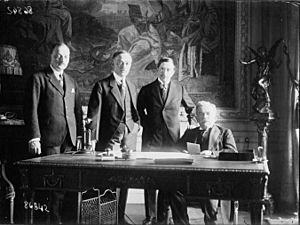Conference of London of 1921–1922 facts for kids
The Conference of London was an important meeting held in London, Great Britain, in 1921 and 1922. Its main goal was to fix problems that came up after World War I. A big issue was the Treaty of Sèvres, which was a peace agreement with the Ottoman Empire. However, a group called the Turkish National Movement was against this treaty and fought against it.
Why was the London Conference held?
After World War I, many peace treaties were signed. One of them, the Treaty of Sèvres, was meant to settle things with the Ottoman Empire. But the new Turkish National Movement, led by Mustafa Kemal Atatürk, did not agree with this treaty. They wanted a different future for Turkey. The Conference of London was called to try and find a peaceful solution and make changes to the Treaty of Sèvres.
First Meeting in London (1921)

The first part of the conference took place in London from February 21 to March 12, 1921. The main Allied powers, known as the Triple Entente (Britain, France, and Italy), wanted to save the Treaty of Sèvres. They tried to get the Turkish nationalists to agree with the government in Constantinople, which was the old Ottoman capital.
However, Bekir Sami Kunduh, who represented the Turkish National Movement from Ankara, had strong opinions. He insisted that the delegate from Constantinople should not be part of the talks. He also completely rejected using the Treaty of Sèvres as the starting point for discussions. This was because the original Sèvres treaty was made with the old Ottoman Empire, not with the new nationalist movement based in Ankara.
Second Meeting in London (1922)
Another meeting was held in London in March 1922. By this time, the Turkish National Movement had become much stronger. Despite their growing success, the Allied powers still hoped to make Ankara accept a slightly changed version of the Sèvres treaty.
The foreign ministers of the Allied powers suggested some new ideas to Ankara:
- They proposed creating an Armenian state in eastern Anatolia.
- They wanted Turkish troops to leave the area around the Straits (important waterways).
- They also demanded that Turkey give up Smyrna and eastern Thrace, including Adrianople, to the Greeks.
In return for these big changes, the Allies offered a few things:
- They would allow the Turkish army to have more soldiers, increasing the limit from the Sèvres treaty to 85,000 men.
- They would remove the European financial controls over the Turkish government.
- However, they wanted to keep the "Capitulations" (special rights for foreigners) and the "Public Debt Commission" (which managed Turkey's debts to European countries).
These proposals were completely against the "National Pact" (National Oath) that the last Ottoman Parliament had agreed upon. The National Pact outlined the goals of the Turkish nationalists for their country's borders and independence. Because of this, the Grand National Assembly of Turkey in Ankara easily rejected all of the Allied proposals.

